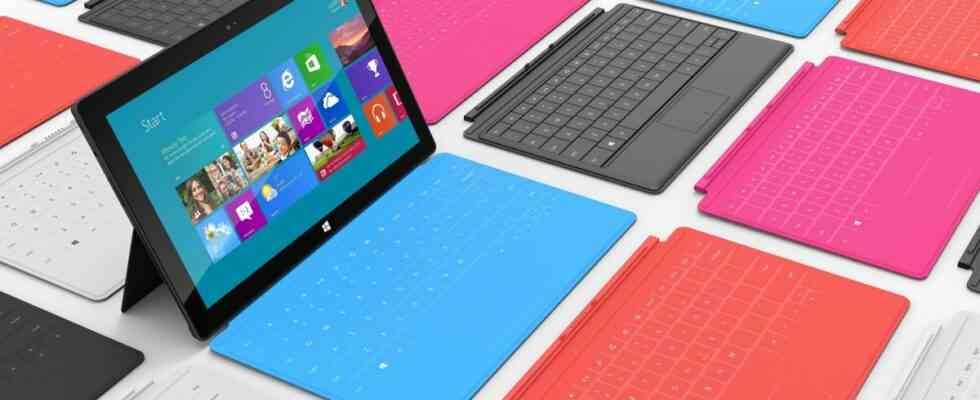Microsoft’s Surface team has cleared the 10-year hurdle and is celebrating its first major anniversary. This is by no means a matter of course, because the beginning was anything but smooth: The Surface RT tablet PC was released on October 26, 2012 and implemented the first ideas that made later models so successful, but remained like lead on the shelves . Also included back then: the kickstand to put the tablet down and the detachable keyboard with touchpad.
Even the first presentation by the then Windows boss Steven Sinofsky was a symbol for the Surface RT: While he was talking about a “great experience”, the tablet fell when opening Internet Explorer in front of the assembled press in the live stream. A short time later Sinofsky vacated his post.
For Microsoft, the Surface RT was a doubly daring experiment. It was not only the first own tablet, it also used the brand new Windows 8 – in a first version for ARM processors, called Windows RT. Nvidia’s Tegra 3 ARM CPU with four Cortex-A9 cores is in the tablet. The app support was mixed and the choice of display also caused eyebrows to twitch: The resolution of 1366 × 768 pixels was low even then for a high-end device. In general, the Surface RT was poorly received, which led to offers of sometimes less than 200 euros and ultimately class action lawsuits from US shareholders.
Surface RT (2012)
Success with x86 processors
Only the Surface Pro from early 2013 put Microsoft’s hardware team on the road to success. It switched from ARM to Intel’s Core i processors (then from the Ivy Bridge generation, i.e. Core i-3000), used a higher-resolution 1080p display and, unlike the Surface RT, could be operated with a pen. 4 instead of 2 GB of RAM also made Windows 8 smoother.
Microsoft didn’t want to bury Windows RT at the time. At the end of 2013, the Surface RT was followed by the Surface 2 with a faster Tegra 4 CPU and a better display, but the selection of apps is still poor. At that time it was already clear that the then Microsoft boss Steve Ballmer would leave the company.
After Ballmer’s departure, it was another six years before Microsoft ventured back into an ARM tablet. However, the Surface Pro X also suffered from the small selection of apps in 2019. In 2022, an x86 emulation will serve as a stopgap, but Windows 11 on ARM lags far behind the app support of Apple’s iPadOS and macOS.
Innovations far from the norm
In the meantime, Microsoft’s hardware team has let off steam on numerous other devices. There’s the Surface Book, which combined a tablet with a large docking keyboard. The trick: The keyboard has an additional battery and an independent GeForce GPU, which significantly increase the battery life and the 3D performance of the 2-in-1 notebook. The Surface Studio was Microsoft’s first all-in-one PC, which uniquely used an elaborate mounting mechanism to use the display like a giant tablet.
The Android smartphone Surface Duo with two displays could be closed. The Surface Neo, with the same idea, but never made it onto the market as a notebook. Other series like the Surface Books were scrapped.
In addition, Microsoft’s later tablets made displays in the high 3:2 format socially acceptable. The Surface Pro 3 from 2014 was the first to switch to the aspect ratio, at that time still 2160 × 1440 pixels. In the meantime, 3:2 and 16:10 displays can be found more and more with many notebook and tablet manufacturers.
Outdated hardware
The Surface team, meanwhile, is not immune to criticism, especially in recent years. The devices often use outdated processors or graphics chips – Microsoft recently introduced the Surface Studio 2 with Tiger Lake CPUs from 2020. If you believe the rumours, the company needs an unusually long time for its own validation tests.
In recent years, Microsoft has also not exactly been innovative when it comes to its hardware. Tablets and notebooks get their annual performance upgrades, but without major design changes. The introduction of Thunderbolt 4 has to serve as a highlight for the Surface Laptop 5 – the connection was not yet available on the 4 model, only on the Laptop Studio and the new tablets.
(mma)

